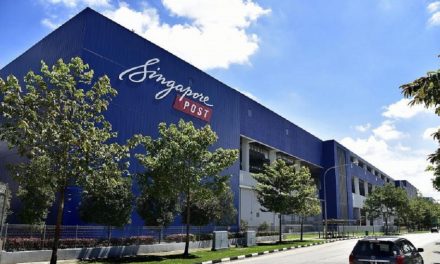
COVID-19: a catalyst for e-commerce

“COVID-19 has given us a taste of what the future of e-commerce can be, but it has also shone a harsh spotlight on the industry’s need to re-engineer the logistics network, and invest into ecommerce-friendly infrastructure”.
MER speaks to Vincent Phang, CEO (Postal Services & Singapore) at Singapore Post to find out how the pandemic has affected the country and how the postal service has created a dependable, cost effective and reliable delivery system that can deal with high-velocity, high-assurance, high-volume deliveries nationwide.
 MER: What effect has the pandemic had on Singapore in general?
MER: What effect has the pandemic had on Singapore in general?
VP: COVID-19 has been the single most disruptive global crisis in recent history. Our way of life has been upended, and countries are even today still grappling to contain the pandemic. As a country that depends heavily on global trade and supply chains, Singapore is particularly vulnerable to disruptions in trade flows, and lockdowns imposed in various countries worldwide at short notice have posed significant challenges for us.
MER: How has SingPost been affected?
VP: The Universal Postal Union’s (UPU) latest report on the COVID-19 impact to global postal operations states: “International flows have been disrupted… with an increasing number of postal items “stranded” in the “logistical no man’s land” between sender and receiver. Delivery and customs clearance times have lengthened, and some international postal bilateral liaisons are not open for private dispatches.” SingPost has not been spared and we have been proactively exploring non-traditional means of delivering across borders. This task is not an easy one, given the evolving international situation which changes on a daily basis, but we continue to soldier on.
MER: What opportunities has the pandemic provided?
VP: COVID-19 has been a catalyst for e-commerce. Data from multiple studies have consistently shown an almost threefold surge in Singapore’s online penetration to 17% in the middle of last year, even as total retail sales plunged 40% including figures from brick and mortar stores.
For SingPost, we experienced an unprecedented 40% surge year-on-year in e-commerce deliveries during the same period, with our postal service responsible for delivering almost half of these volumes. We expect this uptrend to be sustained in the longer term, with lasting changes to consumer behaviour. The logistics sector stands to reap the fruits of this evolution as well, if we are able to overcome the obstacles that the pandemic has placed in our way.
MER: What type of item are Singaporeans buying more of?
VP: At the outset of a national lockdown to curb the spread of COVID-19 imposed by the government from April to June 2020, essential goods and groceries formed the bulk of online purchases as movement restrictions kicked in and brick-and-mortar stores faced inventory challenges due to increased demand for such items. However, as the months progressed, more discretionary purchases like fashion apparel, electronic games and appliances were made. Even in the months following the lifting of the national lockdown, we continued to see sustained volumes for e-commerce deliveries of essential as well as discretionary items, culminating in the year-end peak season just past. Based on the volumes we experienced last year, it is clear that consumers have embraced e-commerce, and view it as a convenient and reliable alternative to the physical shopping experience.
MER: What are the challenges of the surge in e-commerce?
VP: The domestic last-mile delivery sector is highly fragmented, with all providers employing the same mode of delivery: individual drivers in vans who deliver to customers’ doorsteps. This mode of delivery is labour-intensive, fleet-heavy and unsustainable, especially in labour-scarce Singapore.
MER: How can the logistics industry meet this demand?
VP: The logistics industry will need to cut its reliance on manpower and explore faster as well as more efficient methods to ride the e-commerce surge. Technology can help in this regard, but the industry needs to have the courage to make the necessary investments and changes to their operations in order to reap the benefits.
MER: What investment is needed?
VP: For a start, investment into urban infrastructure is vital for an efficient last-mile delivery network. The PostPal smart letterbox that we just rolled out for public trial in December last year is a good example of this. As a smart letterbox with enhanced security features, mail receipt notification capabilities, and mail slots of varying sizes to accommodate postal packages as well as flats, PostPal is far better equipped to handle e-commerce items sent via post than the traditional standard-sized letterbox receptacle secured by a lock and key.
MER: What is SingPost doing to improve its e-commerce offering?
VP: As post – with its cost-efficiency, familiarity and prevalence – is the primary mode for e-commerce items to be delivered, SingPost has also been developing new technologies and solutions to better serve e-commerce customers. The launch of our PostPal smart letterbox – while currently on trial – is an example of our assurance of delivery efficiency tapping on innovation and technology as part of our Future of Post strategy.
MER: What new services has SingPost begun providing as a result of the pandemic?
VP: SingPost launched a comprehensive island-wide medicine delivery service in April, capable of delivering temperature-sensitive supplies that require special handling. The service has been very well-received, as our coverage has expanded from one hospital and three polyclinics when we first launched in April 2020, to all public hospitals and polyclinics nationwide in barely a year. Additionally, we have also been appointed by the government to provide deliveries of high-security items such as passports and identity cards.
MER: What changes have there been on the operational front?
VP: COVID-19 has been tremendously trying on the manpower front. The mandatory imposition of health protocols (e.g. split-team arrangements, donning of PPE, social distancing etc) has lowered productivity, while neighbouring countries’ border closures precipitated a labour crunch. These translated into delivery delays across the board last year. Thankfully, the situation is gradually improving as Singapore takes steps towards vaccinating its population.
More generally, COVID-19 has also accelerated our plans for the Future of Post strategy. The pandemic has painfully highlighted the limitations of a labour-intensive workflow, as well as the urgent need for postal infrastructure to be upgraded to accommodate e-commerce. We have taken the first step towards our Future of Post vision with the launch of PostPal, the world’s first smart letterbox in December last year, and are exploring using technology to enhance other aspects of the postal workflow and customer experience.
 MER: How will PostPal help SingPost?
MER: How will PostPal help SingPost?
VP: As a next-generation, smart letterbox, PostPal offers a myriad of benefits for residents as well as postmen. For postmen, PostPal’s automatic mail sorting function shaves hours off his daily routine, and greatly minimises human error. Incidences of doorstep deliveries due to full letterboxes will also be reduced significantly, as PostPal is capable of dynamic mail allocation based on mail sizes. For residents, PostPal offers unparalleled convenience, security and accuracy. When paired with the SingPost app, residents are able to receive mail receipt notifications whenever mail addressed to them is deposited in PostPal. To collect mail from PostPal, residents need only flash a QR code dynamically generated by the app to the PostPal kiosk, a fast, hassle-free and safe method of mail retrieval process. In addition to improving efficiency and accuracy, PostPal has the potential to upskill our postmen into “postal engineers” responsible for the customisation and maintenance of the kiosks within his beat, upgrading the traditionally labour-intensive job to one that is more technologically inclined. In addition, the capability of PostPal to handle more postal e-commerce items of various sizes and shapes is vital in ensuring that the last-mile needs of Singapore are adequately served given the exponential growth in e-commerce domestically as well as regionally.
MER: How are customers taking to PostPal so far?
VP: PostPal has been rolled out to two public housing blocks thus far as part of a one-year national trial, and reception has been overwhelmingly positive. What has been particularly heartening is that residents of all demographics have been very keen to try it out, and even the elderly have found the learning process to be a breeze.
MER: What are the challenges of PostPal?
VP:As the first letterbox of its kind, we had envisaged some apprehension, especially by more senior residents who may be more used to the traditional letterboxes. We were also concerned that this demographic would require some help in learning how to use PostPal. To address these issues, we organised a week-long outreach exercise, where our staff were stationed on-site to teach residents how to use PostPal. During the development phase of PostPal, user experience was also one of the core pillars buttressing the project, resulting in a mail collection process that is simple and intuitive. Residents have told us that they appreciate the ease at which mail can be collected now, and that they no longer need to regularly blind-check their letterbox due to the mail receipt notifications they receive on their mobile phones.
MER: What tangible changes does PostPal offer to restructuring the postal service? What other spin offs can we imagine from PostPal?
VP: PostPal is but one cog in an overall strategy we have dubbed the “Future of Post”. The FoP project aims to transform the decades-old national postal system to be more adept at e-commerce package deliveries, as well as offer customers a service standard that is in line with their expectations in this digital age. FoP will fundamentally change the way the postal system works by using technology to enhance aspects of our operations that overly rely on manual labour, while future-proofing the jobs of our staff by upskilling them. It is also worth mentioning that volumes of flats have been on a steady decline over the past few years, and its trajectory means we will not be able to rely on it as a primary revenue source for much longer. In a broader context, the transformation wrought by FoP will also accrue benefits on a national scale. An efficient, safe and convenient postal system capable of speedily delivering postal packages will further galvanise the growth of the e-commerce and digitalisation. Small and medium enterprises wary of expanding their businesses online will be encouraged by a postal system that is cost-effective, secure and reliable. Smart letterboxes capable of dispensing mail of varying shapes and sizes to targeted households can also be harnessed for community services, or even serve as distribution points for essential supplies during times of crisis.
MER: What is SingPost’s strategy for the future?
VP: We have to be realistic: the postal infrastructure and workflow today will not be able to handle the surge in volumes for e-commerce items in a future that has been brought forward by COVID-19. We are proactively reviewing our entire postal workflow, with the aim of transforming the decade sold national postal system to be more adept at e-commerce package deliveries. In addition to the PostPal smart letterbox, smart stamps that allow even basic mail to be tracked, as well as an overhaul of the entire postal workflow, are in the works.
MER: Do you think it is possible to achieve this given the unprecedented circumstances?
VP: In my opinion, the transformation we are undergoing is not optional. COVID-19 and the corresponding e-commerce surge has accelerated the need for a thorough revamp of our infrastructure and operations, making these enhancements necessary in order for us to adequately serve our customers. Singapore’s Deputy Prime Minister Mr Heng Swee Keat had last year called for all industries to relook traditional processes to meet the challenges of the post-COVID world, and as the national postal service provider, we lead the domestic logistics industry in heeding this call. Should we succeed, we can solidify Singapore’s reputation as a trusted and resilient supply chain node for global e-commerce flows.
 About Vincent Phang
About Vincent Phang
Mr Phang joined SingPost in April 2019 as Chief Executive Officer for Postal Services and Singapore, which encompasses all of SingPost’s core business in Singapore, including Post, Parcel and Logistics. In this role, Mr Phang is responsible for leading the delivery network in Singapore, through a comprehensive and customer-centric suite of logistics, mail and parcel solutions for our customers. He is also responsible for SingPost’s international postal relationships. Mr Phang has over 20 years of regional experience in the supply chain, logistics, industrial and manufacturing industries in Asia, having served in various senior leadership roles including Group CEO of ST Logistics. Mr Phang holds a Master in Engineering (First Class) in Aeronautical Engineering from the Imperial College, UK and has also attended the Advanced Management Programme at Harvard Business School in 2014.








